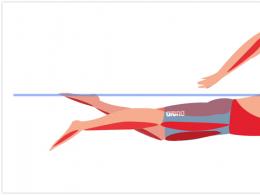Sale of especially rare and valuable items. How to sell Soviet rare items on Etsy. Envelopes and stamps
You may have a real treasure in your closet, garage or dacha, and you don’t even know about it. You might even be thinking about throwing it away. Stop! And check out this review. We have collected ten things that many of you have, and their cost may pleasantly surprise or even shock you a little.
Dulevo porcelain
Can be identified by the “Dulyovo” brand. These items have become more expensive than their original cost and are highly sought after by antique dealers. Simple porcelain figurines, which used to be in every second apartment, today can bring the owner up to 10 thousand rubles apiece. And the rarest one is sold at various auctions from 250 to 630 thousand rubles. This is “Mom with a Stroller” - a serial figurine by N. Malysheva. It is extremely rare even among antique dealers.
Pedal cars
In the USSR, children simply loved to ride pedal cars. True, only the truly lucky ones owned them, while everyone else rented them at recreation parks. Such machines cost about 30 rubles, a considerable amount for those times. Now pedal-powered Muscovites and ZILs are gaining value. Even a badly damaged and rusty car can, in principle, be sold for 3 thousand. On average, their price ranges from 5 to 15 thousand rubles. A pedal “horse” in excellent condition is sold for 40-60 thousand.
TV "KVN-49"
The first mass-produced television in the USSR is still popular among antique lovers. Even for a non-working one you can get almost 10 thousand, and if it also shows, then the purchase price will be twice as expensive.

Porcelain LFZ
Figurines from the famous Imperial Porcelain Factory (during the years of Soviet power, the Leningrad Porcelain Factory) are also much more expensive. In antique stores, the cheapest copies are priced at 5 thousand rubles. There are also more expensive copies. For example, a figurine of Stepan Razin costs about 80-85 thousand rubles.
Vinyl player
Nowadays the fashion for records is being revived. Companies release additional copies of already known albums, and young bands do not forget about vinyl when recording new albums. A working player, depending on the condition and company, can be sold from 1 to 10 thousand rubles. By the way, records are also selling well, but listeners are more interested in classic rock.
Cast iron figurines
Cast iron figurines from the USSR are prized among collectors. Some figures can be sold for 50-60 thousand. Kasli casting is especially valued. They were produced in the Chelyabinsk region, with special characteristics - clarity of silhouette, carefully finished parts and coating of finished products with black paint of a special recipe.
Surprisingly, for some reason the popularity of Krasnaya Zarya fragrances has suddenly revived again. Retro fashionistas will happily grab a bottle of Natasha, Red Poppy and other Soviet scents. The price depends on the rarity of the fragrance, year of release and condition. Open bottles are periodically purchased, but they are inexpensive. But the price for unopened perfume reaches 5 thousand.
Ready room
As a child, almost no one could remember this strange and funny word that was used to call this velvet box with compasses and other incomprehensible things. Nobody explained to me why it was needed in almost every home, because modern schoolchildren only need one compass. But Soviet cooking equipment can be sold for decent money. Even the simplest options cost from a thousand rubles, and if you have a German-made set, you can sell it for as much as 40 thousand.
Christmas decorations
Soviet glass Christmas tree decorations delighted the eye at every holiday, how garlands and candles were reflected in them, and how offensive it was when something broke. Nowadays there are more and more Chinese plastic toys in the store, so the demand for Soviet glass or toys from the GDR is growing every year. Even for things with minor defects, collectors are willing to pay 200-400 rubles, and for rare items in good condition they shell out thousands.
Dolls
It is not clear whether there is a great demand for Soviet plastic dolls, but there are many advertisements on Avito where Soviet dolls are sold starting from 500 rubles and up to several thousand. Dolls made in the GDR are especially valued; they say every Soviet girl dreamed of one.
In the rubble of most “grandmother’s attics” there are things from the USSR. Some of them may turn out to be a real rarity and have the cost of a high-quality foreign car. Isn't it time to check your own closets and mezzanines?
The past era of socialism left a rich heritage in the form of antiques, objects of everyday life and political life of citizens of the Union Republics. What Belarusian house does not have at least one trinket or postcard left from those times? But it may turn out that this very postcard is a tidbit for collectors, and with the money from its sale you can buy, for example, a dacha or an entire house.
Let's figure out what antique dealers are hunting for and what they won't take even with an additional payment.
Porcelain products
Porcelain dishes in sets, as well as in the form of individual elements, are of considerable value to collectors. Products from Leningrad, Minsk, Kirov, Baranovsk and other Soviet factories are in demand. Belonging to the product of one or another is determined by the presence of a mark on the bottoms (sometimes with the author’s signature of the artist or sculptor).
Prices range from several hundred to several thousand dollars. For example, the “Golden-Maned Horse” tea set with cups painted “Red Cockerels” from the 1960s (E. Krimmer, A. Vorobievsky, LFZ) is valued by antique dealers at about $600.
Demand for porcelain figurines from limited factory releases is growing. Not only the condition of the product plays a role in pricing, but also the theme of the plot (the more erotic, the more expensive).

Something as common in Soviet times as a cup holder may now turn out to be a small treasure for its owner. This is especially true for silverware that belongs to original works and is marked with the artist’s mark. An example is the “Swans” glass holder made of 875 sterling silver (marked MYuZ, 1932) for sale at a price of almost 650 euros. Ordinary products can be found for several hundred thousand Belarusian rubles.

Cast iron figurines, timepieces, ashtrays and other things are not a cherished goal for antique dealers. However, they are willing to pay a lot of money for exclusive items. For example, a figurine of Voroshilov with hands in gauntlet gloves and on a horse is considered very valuable. Due to the limited edition of this batch, the figure is valued at up to $30,000.
Objects from rare collections of Kasli casting (Ural) are in demand among collectors. Prices range from several hundred to a couple thousand dollars.

Such devices can be sold at a high price only if they remain in good appearance and working condition. For example, one of the first TVs of the KVN-49 type with a magnifying lens for the screen (working) can be sold for several hundred dollars if you find a good buyer. But in most cases, radios, televisions, players, gramophones are valued at several million at best, and at worst a couple of hundred thousand Belarusian rubles.

They also make money by selling toy cars, tanks and other “equipment”. The better the safety of an item and the more complete the equipment, the more valuable it is. Soft toys and dolls cost less, but if you find a very keen collector, you can negotiate for more.
Christmas tree decorations are not considered a rarity on the antique market. But if you have glass jewelry from the first decades of the USSR lying around, you can count on an increase in their price.

Engravings, drawings and paintings by Soviet artists have a very wide range of prices. This is influenced by the popularity of the author of the work, the material used, and the period of creation. The theme of the plot is also important. Industrial views of Soviet cities, the Kremlin, portraits of party leaders, and propaganda subjects are considered more valuable. The cost of such images can reach several tens of millions of Belarusian rubles.
The price of records varies from 10 thousand to tens of hundreds of rubles. Some sell them in whole albums. The cost of such a selection is about 700 thousand Belarusian rubles.
Souvenir products
This category includes various figurines dedicated to significant events, busts and sculptures of political figures and leaders, vases with portraits of astronauts and other personalities famous and important for the life of the country, badges of circles and meetings and other items.
A few examples:
- glass vase with a portrait of cosmonaut G. Titov (casting, painting, second half of the 20th century) - about a million rubles;
- award cup of the All-Belarusian Spartakiad 1955-1956. (bronze casting with silver plated and hand-painted with the author’s signature) - about 10 million Belarusian rubles;
- souvenir plate of the Navy of the second half of the 20th century (overglaze painting, PVI) - about 5.5 million Belarusian rubles.
Trotsky figurines are considered valuable, since there are very few of them left - after his deportation, it was ordered to destroy all paraphernalia dedicated to this political figure.
You can even sell collections of chewing gum candy wrappers, the main thing is to find a hunter for this product. But before that, be sure to study the offers of the antique market and ask the price so as not to lose where you could win.
“Do not rush to throw away, burn or scrap things in an old house,” warns director of an antique salon from Chelyabinsk Vladimir Antropov. - Perhaps they are of no value to you. But their actual cost these days may surprise you. Therefore, first, take photographs of household and interior items, at least in general terms, and show the pictures to a knowledgeable person.”
Million for an accordion
Almost all popular sites with advertisements for the sale of personal items today have an “Antiques” section. Whatever they sell there! Old irons, toys, furniture, radios, record players, vinyl records, crystal, badges, orders, medals, inkwells, binoculars, candlesticks, cup holders, ashtrays and cigarette cases. And that's not all. The price range is impressive. So, one friend asks 5 thousand rubles for a mortar and pestle and a couple of cast iron pots. Another is selling a Soviet radio for 10 thousand rubles. The third is a sewing machine for the same price. Someone put up an antique sideboard for sale for 30 thousand rubles.
The highest prices for musical instruments. For 5 thousand rubles you can buy a mandolin. Accordions and accordions cost between 10 and 25 thousand rubles. A German piano with ivory keys is sold for 50 thousand rubles. Another piano - also German - already costs 400 thousand rubles. The record holder for the cost of goods is an advertisement for the sale of an Italian Scandalli accordion, made in 1960. “Fine factory inlay with Swarovski rhinestones, keys and registers made of natural ivory, six dampers, copper voices! - the owner reports about the advantages of the instrument. “An accordion with a good history, belongs to a professional musician, Honored Artist of Russia.” They are asking for no less than 1 million rubles for the instrument.
Should I store trash?
“The impression is that people take the first numbers that come to mind as a price! - Vladimir comments. - Not all old objects are worth money, but only those that have artistic value. Sewing machines, irons and spinning wheels are offered to us several times a day. But what was widely circulated, found in every home and in every family, is worth nothing. Even in historical museums they don’t accept such goods for nothing: there are a lot of similar exhibits. You can endlessly try to sell such an inheritance on an advertisement site. But, of course, not for a million, not for a hundred, or even for ten thousand rubles. It’s good if someone buys it for 1-2-3 thousand! And there is no point in keeping these things any longer: firstly, they are unlikely to rise in price, and secondly, they can turn into real trash.”
According to experts, sideboards and chests of drawers from Soviet times have no value, unlike furniture from pre-revolutionary times made of valuable wood. Any antique dealer will be interested in the porcelain and cast iron figurines that adorned the shelves of sideboards during the Soviet era. For example, a porcelain composition from the 70s “Artemon and Malvina”, only 13 cm high, today costs 30 thousand rubles. And the figure based on Gogol’s work “The Night Before Christmas” Cherevichki” - almost 40 thousand rubles. Kasli castings cost differently: sometimes you can get 3 thousand rubles for a figurine, or 30 thousand or more. What matters here is the year of manufacture, who the author of the product is and what edition it was cast in.
“Before 1960, the quality of casting was excellent,” explained the head of another antique salon from Yekaterinburg Stanislav, - after that it already left much to be desired. What is being cast now is of no use to anyone. They are cast using the same molds, but a new figurine is easy to distinguish from one that was cast 70-80 years ago and has managed to acquire a kind of patina. Although there are also craftsmen who artificially age new figurines so that it is very difficult to distinguish them from old ones.”
Icons are like gazelles!
Under Soviet rule, it was impossible to sell anything. When the Union collapsed, people took everything that could be sold to antique dealers. It was noticed that the most icons were sold at the turn of 2000.
“Icons, medals and orders could be loaded with gazelles,” recalls Stanislav. - And they gave it away for next to nothing. Although their real prices were off the charts. Today, the most valuable icons are those of lectern size (27 by 32 cm) with a silver frame. You can earn from 30 thousand rubles to a million for them. What is sold today in churches and icon shops is consumer goods; no one will ever buy these icons.”
One of the main places on the list of desired exhibits among admirers of antiques is occupied by samovars. And no wonder: they are an integral attribute of Russian history and culture. The first samovars were made by St. Petersburg and Tula craftsmen and only by hand. In the mid-19th century, there were 28 samovar factories in Tula, which produced 120 thousand samovars a year! This is where the expression came from: people don’t go to Tula with their own samovar. The names of Tula samovar makers are known to this day - Lomovs, Lisitsins, Batashevs, Kapyrzins, Teyle, etc. The copies made by their hands are considered the rarest, therefore they are the most expensive on the antiques market.
“I buy any samovars, even Soviet ones,” says Stanislav, “the main thing is that they are coal. The price of a samovar depends on who the author is. And the more bizarre the shape, the more expensive it is. The price of Soviet coal samovars starts from 1.5 thousand, the price of samovars from tsarist times (before 1917) can reach 100 thousand. One problem: such old exhibits often lack something, something is broken, they are in poor condition. Because of this, the price goes down.”
As for old money, not all antique dealers take it: they are afraid of counterfeits. In addition, old Russian money is of little value; experts give preference to Asian and European money. Moreover, banknotes: coins have practically no price, especially if they were issued later than 1900.
A reasonable question arises: who buys from antique dealers what they buy from the public and at auctions?
“We divide our customers into three categories,” says Vladimir Antropov. - The first is collectors. The second is people who purchase antiques as a gift for a person who already has everything and who is very difficult to surprise. The third category is people nostalgic for the old days. They mainly buy interior items to decorate their homes. By the way, often among them there are directors of antique-style restaurants.”
Who among us does not dream of suddenly becoming rich: receiving an inheritance, winning the lottery or finding a treasure? There are many fairy tales about this and even more films have been made. But fantasies, alas, remain fantasies. Although... Sometimes treasures are right before our eyes. Don't believe me? Then look into your own kitchen or grandma's old sideboard. And if you find things from this list there, rejoice: today they can be sold for good money. Vintage is back in fashion!
Antiques have always been prized by collectors and lovers of curiosities. But the market for old items has many pitfalls. Firstly, ordinary people often don’t even suspect that among all sorts of trinkets and “unnecessities” they keep a potential source of income at home. And, secondly, they have no idea how and where to sell all this stuff.
1. Crystal
Bohemian, French - whatever you like. What most of us consider a relic and forgotten luxury of the Soviet era is now becoming increasingly popular in the West. Moreover, imitation crystal can be found even in the latest collections of mass market brands like IKEA. Why not unload the sideboard?
2. Old Pyrex cookware collections
Heat-resistant Pyrex glassware is wildly popular among modern fashionistas and desperate housewives. But for true hipsters and lovers of culinary delights, pots and kettles from collections twenty years ago or more are of much greater value. Yes, in our area, French dishes were a rare guest. But if you are lucky enough to have friends or relatives abroad who brought such exotic gifts, mentally thank them and feel free to put the vintage up for sale.

3. Old perfume bottles
Ideally, crystal, with a ground-in lid. They are what are sought at auctions not so much by perfume lovers as by collectors and even interior designers.

4. Christmas decorations
Believe it or not, old Christmas tree decorations, even from the Soviet era, are simply a blessing for collectors! It’s just a pity that, due to the fragility of the “rarity,” not everyone manages to keep it intact.

5. Cookie cutters
Original cookie cutters are highly valued among owners of cafes and small pastry shops.
The older, the better. And if they are also timed to coincide with some holiday or historical event, then it’s a treasure!

6. Wicker furniture
Old wicker furniture is literally in great demand among both collectors and designers.
It will be difficult to forward, but it will be worth it.

7. Lithography
A treasure hidden in plain sight.
Food for thought: In the West, lithograph paintings from the Currier and Ives series, popular and widely available in the early 20th century, still hang on the walls of many homes. Meanwhile, at auctions their cost reaches $100,000. There's a lot to think about.

8. Ceramic figurines
Determining true value is not so easy.
The difficulty is that their true value can only be determined by professionals. But if you are lucky enough to keep a rare figurine, you can get good money for it.

Pioneer badges, grandfather's books, grandmother's dinnerware and father's records. These trinkets that collect dust in our homes can cost a pretty penny. Let's figure out how to profitably sell something unnecessary.
Rare coins

You can earn up to 250 thousand rubles.
What to sell: Look for rare coins in your wallet - maybe you were accidentally given 50 kopecks in change, which collectors will value at one hundred thousand rubles? Of the modern ones, the five-ruble notes of the St. Petersburg Mint of 1999 (more than 250 thousand rubles) and 2003 (up to 6 thousand), the two-ruble notes of the Moscow Mint of 2001 (up to 30 thousand), the St. Petersburg Mint of 2003 (from 8 thousand), as well as coins with Gagarin without a mint mark (up to 3 thousand rubles). In addition, you can sell commemorative coins - check the cost of each specific coin on profile websites. And at the same time, it’s worth thinking about this way of earning money: creating Internet sites.
Where to sell: Banks, for example Sberbank, periodically buy rare coins, but not everyone is ready to wait for the next such promotion. The easiest way is to sell the coin to buyers, who then arrange them in albums and resell them to collectors.
And the most profitable thing, of course, is to sell the coin directly to collectors. To do this, find the appropriate forum or group on a social network in your region.
Old laptops and phones

You can earn up to 40 thousand rubles on a working laptop and up to 8 thousand on a broken one.
What to sell: Don't rush to take your equipment to the landfill. Firstly, it cannot be thrown into ordinary containers, and, secondly, it can be sold at a profit. In large cities, almost any electronics repair shop buys old computers for parts. For good laptops in working condition in Moscow, on average, they offer 20-25 thousand rubles. For broken or very old ones - 6-8 thousand.
The average price for used smartphones in working condition ranges from 30 to 50 percent of the cost of a new device of the same type on the market. For a broken one they will give at most a couple of thousand, but this is also money, especially considering that for you such a thing is, in fact, garbage.
Where to sell: Contact a computer electronics repair point or a special website on the Internet - many of them are even ready to go to the client to pick up his old laptop or smartphone. Just call several companies first - perhaps somewhere they will offer you a higher price.
Vinyl records

You can sell one record for an average of 50-300 rubles.
What to sell: Many of us still have vinyl records in our homes or garages. If the player for them is broken, and you are not ready to spend incredible money on a new one, the vinyls can be sold. The general rule is: the older the record, the more expensive it is. The exception is limited and rare editions, which are now almost impossible to get.
Where to sell: The records are purchased by specialized stores, as well as collectors on social networks. Selling records one at a time is inconvenient, unless, of course, we are talking about rare collectible vinyl. At online auctions, large selections without descriptions also go poorly, so it’s better to turn to professionals. There are plenty of such companies in Moscow and other large cities.
Soviet badges

You can earn from 3 thousand rubles to one and a half thousand dollars.
What to sell: Not all Soviet badges are valuable, but only those made of heavy metals and, preferably, before the 1950s - they can be sold for 3-5 thousand rubles apiece. The more complex the icon is, the better. Also, the price depends on the circulation - if it is less than 10 thousand copies, the cost rises sharply. Rare badges with history and documents are especially valuable - their price can reach up to $1,500.
Where to sell: The simplest, but quite effective option is online auctions and sites such as “Molotok” or “Avito”. If you live in Moscow, in good weather you can go to the Zhukov monument on Manezhnaya Square - near it there are both sellers of exotic items for tourists and real collectors.
Rare book editions

You can earn from 200 to 20,000 rubles.
What to sell: If you have a book “lying around” at home that was published before the Great Patriotic War, or, even more so, before the revolution, its value is likely to be quite high. But what to do with Soviet books purchased in the 1970s and 80s? Before you take them to the nearest library, look through the titles.
The market values, for example, books in the series “Philosophical Heritage” (1,500-3,000 rubles per edition), “Library of World Literature” (from 200 to 700 rubles per volume), as well as the complete works of Lenin and Stalin (15-20 thousand rubles for a complete selection of the 1950s). In addition, at online auctions, it is quite possible that you will be happy to buy small-circulation books (up to 1000 copies), but this can take a lot of time, since connoisseurs are quite rare.
Where to sell: In the Russian segment of the Internet, perhaps the largest platform for selling second-hand books is Ozon, but you can cooperate with it directly only by registering an individual entrepreneur or a legal entity. If you don't want to bother with this, take the books to a good second-hand bookstore.
True, central stores, such as, for example, Biblio-Globus, only accept publications before 1950, and the Moscow bookstore generally requires a list first, and only then promises to contact you if something interests them. Therefore, less picky retail outlets or the Internet are preferable for you.
Soviet porcelain

You can earn from several hundred to several tens of thousands of rubles.
What to sell: Did your grandmother leave Soviet dishes in the sideboard? Don't rush to throw it away. Perhaps the Soviet porcelain preserved in your home is valuable for collectors.
Mid-century figurines can easily fetch a couple of thousand rubles in antique shops, and pre-war examples are valued even more. Rare author's sculptures can even reach several thousand dollars in price, but this is unlikely to be in your sideboard, unless your grandfather was a major party official.
Where to sell: You can sell porcelain to collectors yourself, on websites such as Molotok or Avito, or you can take it to an antique store, where the figurine will be valued and a buyer will be found. True, in this case you risk making a mistake and hearing an unreasonably low price from the antique dealer. Therefore, it is better to first ask collectors to estimate the approximate cost of porcelain on a specialized forum.





